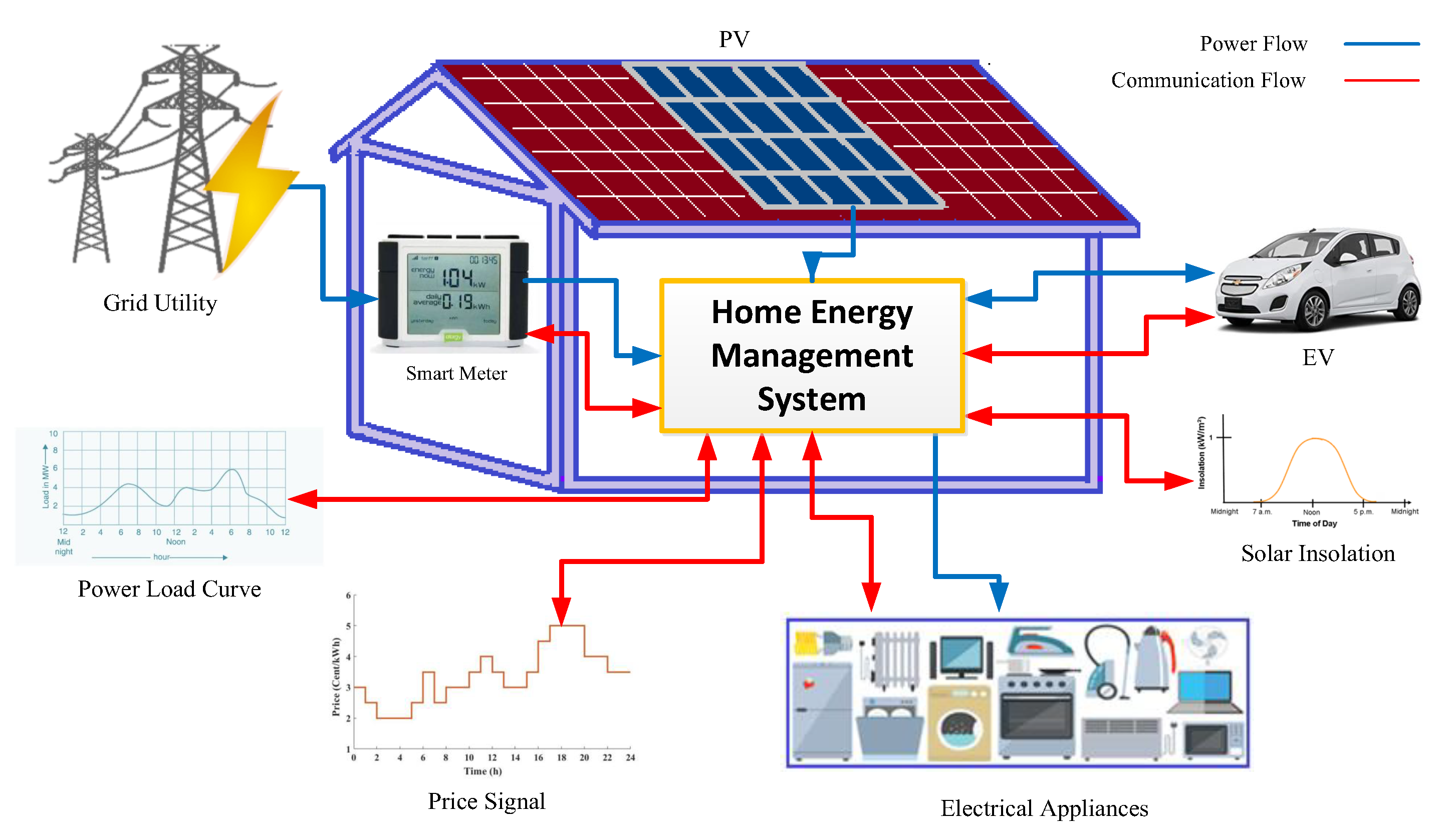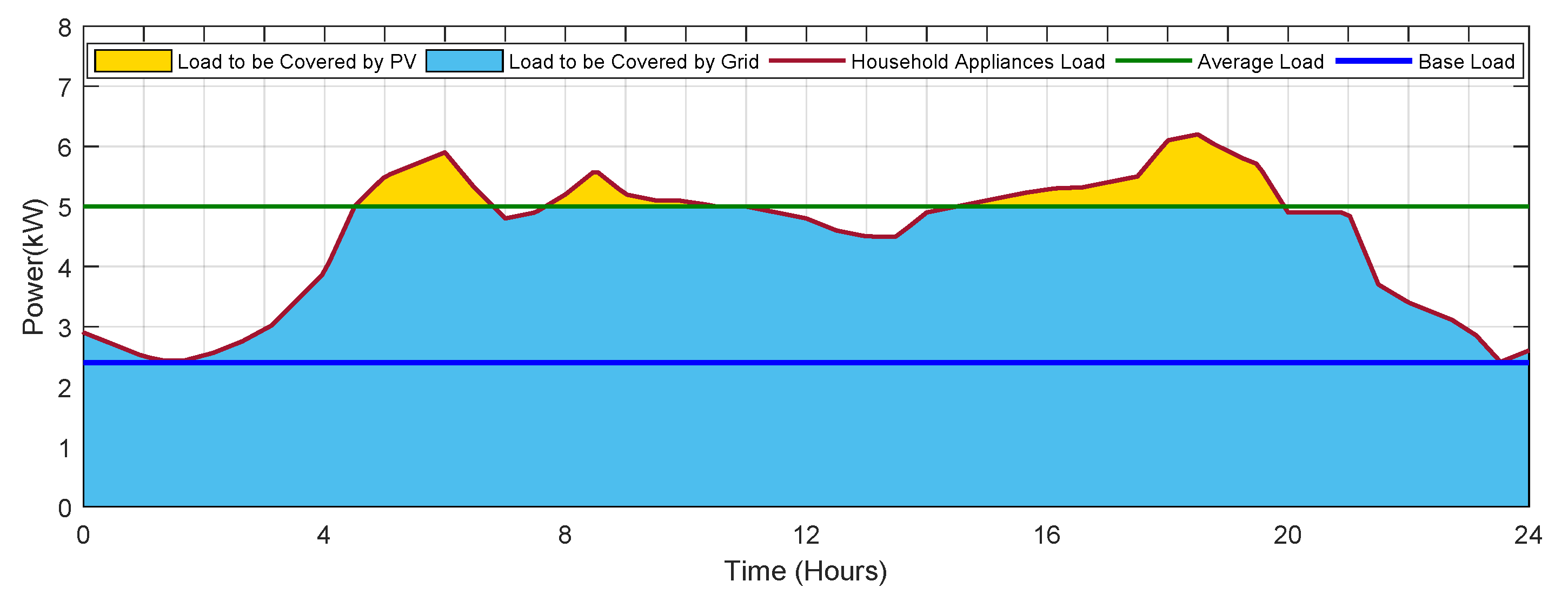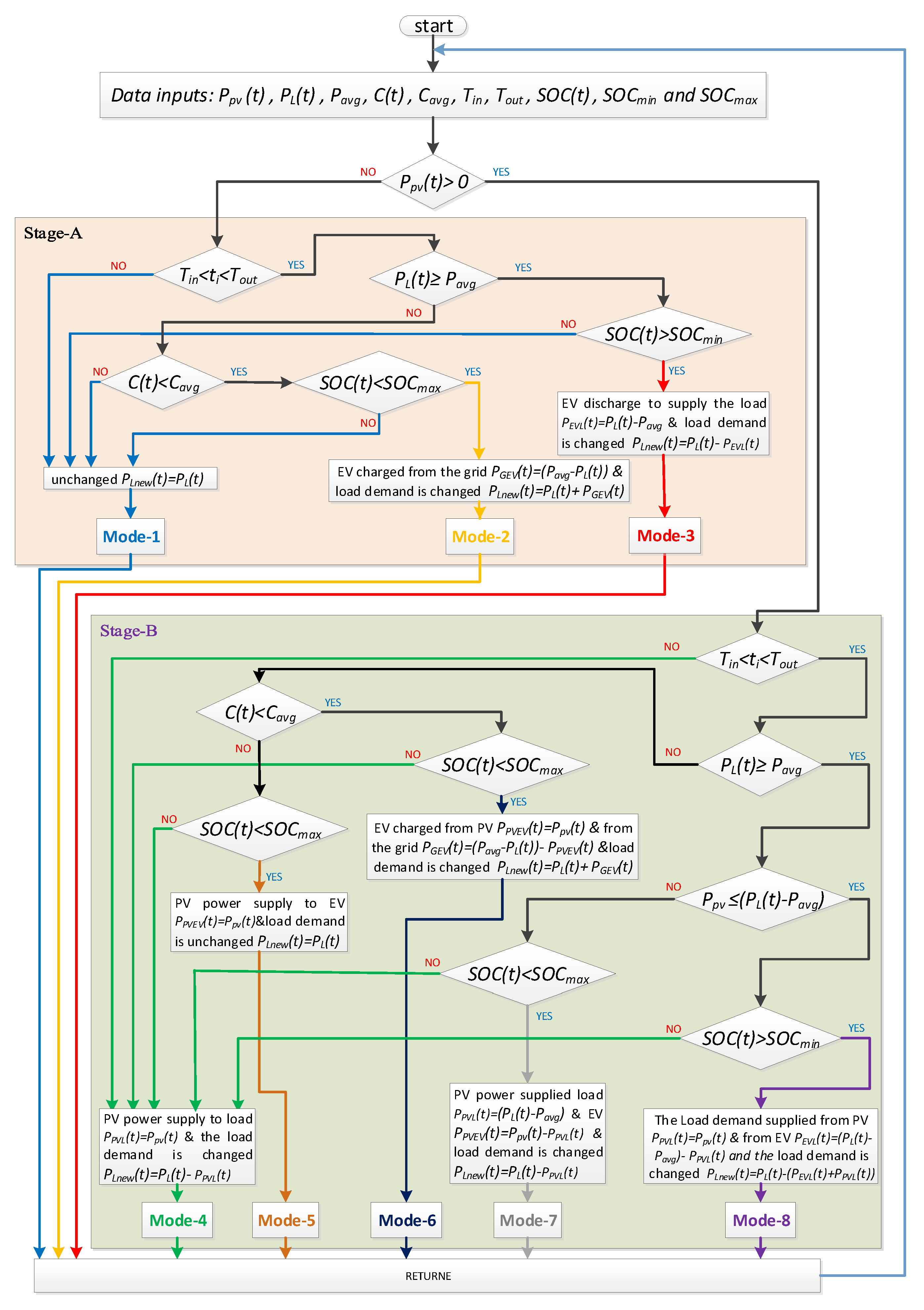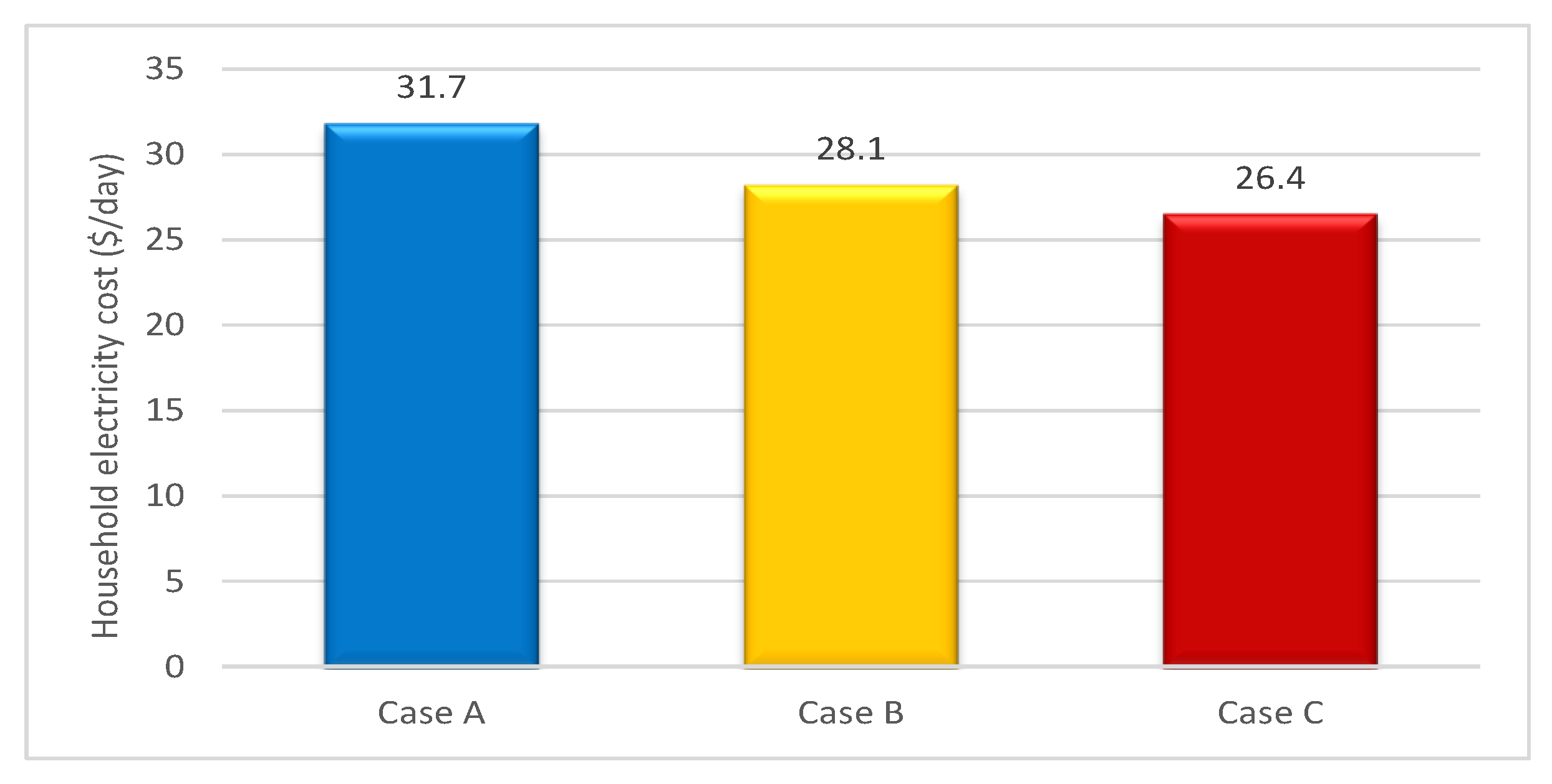Two-Stage Energy Management Strategy of EV and PV Integrated Smart Home to Minimize Electricity Cost and Flatten Power Load Profile
Abstract
:1. Introduction
2. System Description and Modeling
2.1. System Description
2.2. System Modeling
2.2.1. Solar Photovoltaic Panel
2.2.2. Electric Vehicle Modeling
2.2.3. Household Load Demand
3. Proposed Energy Management Strategy
3.1. Proposed Energy Management Strategy for Smart Home Integrated with EV, and PV
- Determine the low and high periods of electricity price.
- Detect the high and low electricity consumption periods in the studied home.
- Reduce the electricity cost and fill the valley thanks to charging EV from grid utility when the electricity price is low and electricity consumption is low simultaneously.
- Control the state-of-charge of electric vehicle battery to prevent the overcharge and over-discharge during charging and discharging, respectively.
- Determine the periods of a negative correlation among PV generation and the load that must be covered by PV generation to charge the electric vehicle from the surpluses PV generation.
- Reduce the peak load thanks to electric vehicle discharge to feed the load demand during the peak load period.
3.1.1. Stage A
3.1.2. Stage B
3.2. Proposed Energy Management Strategy for Smart Home Integrated with EV without PV
4. Economic Analysis
4.1. Case A: Home Equipped with EV and without EMS
4.2. Case B: Home Equipped with EV and EMS
4.3. Case C: Home Equipped with EV, PV, and EMS
5. Results and Discussion
6. Conclusions
Author Contributions
Funding
Conflicts of Interest
References
- Liu, K.; Wang, Q.; Luo, Z.; Zhao, X.; Su, S.; Zhang, X. Planning Mechanism Design and Benefit Analysis of Electric Energy Substitution: A Case Study of Tobacco Industry in Yunnan Province, China. IEEE Access 2020, 8, 12867–12883. [Google Scholar] [CrossRef]
- Savio, D.A.; Juliet, V.A.; Chokkalingam, B.; Padmanaban, S.; Holm-Nielsen, J.B.; Blaabjerg, F. Photovoltaic integrated hybridmicrogrid structured electric vehicle charging station and its energymanagement approach. Energies 2019, 12, 168. [Google Scholar] [CrossRef] [Green Version]
- Sinsel, S.R.; Riemke, R.L.; Hoffmann, V.H. Challenges and solution technologies for the integration of variable renewable energy sources—A review. Renew. Energy 2020, 145, 2271–2285. [Google Scholar] [CrossRef]
- Kemmler, T.; Thomas, B. Design ofHeat-Pump Systems for Single-and Multi-Family Houses using a Heuristic Scheduling for the Optimization of PV Self-Consumption. Energies 2020, 13, 1118. [Google Scholar] [CrossRef] [Green Version]
- Kapustin, N.O.; Grushevenko, D.A. Long-term electric vehicles outlook and their potential impact on electric grid. Energy Policy 2020, 137, 111103. [Google Scholar] [CrossRef]
- Luthander, R.; Shepero, M.; Munkhammar, J.; Widen, J. Photovoltaics and opportunistic electric vehicle charging in the power system—A case study on a Swedish distribution grid. IET Renew. Power Gener. 2019, 13, 710–716. [Google Scholar] [CrossRef] [Green Version]
- Wi, Y.M.; Lee, J.U.; Joo, S.K. Electric vehicle charging method for smart homes/buildings with a photovoltaic system. IEEE Trans. Consum. Electron. 2013, 59, 323–328. [Google Scholar] [CrossRef]
- Tarroja, B.; Eichman, J.D.; Zhang, L.; Brown, T.M.; Samuelsen, S. The effectiveness of plug-in hybrid electric vehicles and renewable power in support of holistic environmental goals: Part 2-Design and operation implications for load-balancing resources on the electric grid. J. Power Sources 2015, 278, 782–793. [Google Scholar] [CrossRef]
- Lakshmi, G.S.; Rubanenko, O.; Hunko, I. Renewable Energy Generation and Impacts on E-Mobility. In Proceedings of the Journal of Physics: Conference Series, International Conference on Computer and Electrical Engineering, TU Delft, The Netherlands, 6–8 November 2019; Volume 1457, p. 012009. [Google Scholar]
- Daki, H.; El Hannani, A.; Aqqal, A.; Haidine, A.; Dahbi, A. Big Data management in smart grid: Concepts, requirements and implementation. J. Big Data 2017, 4, 1–19. [Google Scholar] [CrossRef] [Green Version]
- Shakeri, M.; Shayestegan, M.; Abunima, H.; Reza, S.S.; Akhtaruzzaman, M.; Alamoud, A.R.M.; Sopian, K.; Amin, N. An intelligent system architecture in home energy management systems (HEMS) for efficient demand response in smart grid. Energy Build. 2017, 138, 154–164. [Google Scholar] [CrossRef]
- Leitao, J.; Gil, P.; Ribeiro, B.; Cardoso, A. A survey on home energy management. IEEE Access 2020, 8, 5699–5722. [Google Scholar] [CrossRef]
- Olsen, D.J.; Sarker, M.R.; Ortega-Vazquez, M.A. Optimal penetration of home energy management systems in distribution networks considering transformer aging. IEEE Trans. Smart Grid 2016, 9, 3330–3340. [Google Scholar] [CrossRef]
- Luo, F.; Ranzi, G.; Kong, W.; Dong, Z.Y.; Wang, F. Coordinated residential energy resource scheduling with vehicle-to-home and high photovoltaic penetrations. IET Renew. Power Gener. 2018, 12, 625–632. [Google Scholar] [CrossRef]
- Datta, U.; Kalam, A.; Shi, J. Electric vehicle (EV) in home energy management to reduce daily electricity costs of residential customer. J. Sci. Ind. Res. 2018, 77, 559–565. [Google Scholar]
- Wu, X.; Hu, X.; Yin, X.; Moura, S.J. Stochastic optimal energy management of smart home with PEV energy storage. IEEE Trans. Smart Grid 2016, 9, 2065–2075. [Google Scholar] [CrossRef]
- Khemakhem, S.; Rekik, M.; Krichen, L. A flexible control strategy of plug-in electric vehicles operating in seven modes for smoothing load power curves in smart grid. Energy 2017, 118, 197–208. [Google Scholar] [CrossRef]
- Khemakhem, S.; Rekik, M.; Krichen, L. Double layer home energy supervision strategies based on demand response and plug-in electric vehicle control for flattening power load curves in a smart grid. Energy 2019, 167, 312–324. [Google Scholar] [CrossRef]
- Rana, R.; Prakash, S.; Mishra, S. Energy Management of Electric Vehicle Integrated Home in a Time-of-Day Regime. IEEE Trans. Transp. Electrif. 2018, 4, 804–816. [Google Scholar] [CrossRef]
- Erdinc, O.; Paterakis, N.G.; Mendes, T.D.; Bakirtzis, A.G.; Catalao, J.P. Smart household operation considering bi-directional EV and ESS utilization by real-time pricing-based DR. IEEE Trans. Smart Grid 2014, 6, 1281–1291. [Google Scholar] [CrossRef]
- Wu, X.; Hu, X.; Moura, S.; Yin, X.; Pickert, V. Stochastic control of smart home energy management with plug-in electric vehicle battery energy storage and photovoltaic array. J. Power Sources 2016, 333, 203–212. [Google Scholar] [CrossRef] [Green Version]
- Aznavi, S.; Fajri, P.; Asrari, A.; Harirchi, F. Realistic and intelligent management of connected storage devices in future smart homes considering energy price tag. IEEE Trans. Ind. Appl. 2019, 56, 1679–1689. [Google Scholar] [CrossRef]
- Lee, S.; Choi, D.H. Energy Management of Smart Home with Home Appliances, Energy Storage System and Electric Vehicle: A Hierarchical Deep Reinforcement Learning Approach. Sensors 2020, 20, 2157. [Google Scholar] [CrossRef] [PubMed] [Green Version]
- Krismadinata, N.A.R.; Ping, H.W.; Selvaraj, J. Photovoltaic module modeling using Simulink/Matlab. Procedia Environ. Sci. 2013, 17, 537–546. [Google Scholar] [CrossRef] [Green Version]
- Laudani, A.; Fulginei, F.R.; Salvini, A. Identification of the one-diode model for photovoltaic modules from datasheet values. Sol. Energy 2014, 108, 432–446. [Google Scholar] [CrossRef]
- Hossain, C.A.; Chowdhury, N.; Longo, M.; Yaici, W. System and cost analysis of stand-alone solar home system applied to a developing country. Sustainability 2019, 11, 1403. [Google Scholar] [CrossRef] [Green Version]
- Wang, Q.; Jiang, B.; Li, B.; Yan, Y. A critical review of thermal management models and solutions of lithium-ion batteries for the development of pure electric vehicles. Renew. Sustain. Energy Rev. 2016, 64, 106–128. [Google Scholar] [CrossRef]
- Zhu, R.; Duan, B.; Zhang, C.; Gong, S. Accurate lithium-ion battery modeling with inverse repeat binary sequence for electric vehicle applications. Appl. Energy 2019, 251, 113339. [Google Scholar] [CrossRef]
- Lu, L.; Han, X.; Li, J.; Hua, J.; Ouyang, M. A review on the key issues for lithium-ion battery management in electric vehicles. J. Power Sources 2013, 226, 272–288. [Google Scholar] [CrossRef]
- El-Sehiemy, R.A.; Hamida, M.A.; Mesbahi, T. Parameter identification and state-of-charge estimation for lithium-polymer battery cells using enhanced sunflower optimization algorithm. Int. J. Hydrog. Energy 2020, 45, 8833–8842. [Google Scholar] [CrossRef]
- Saberi, K.; Pashaei-Didani, H.; Nourollahi, R.; Zare, K.; Nojavan, S. Optimal performance of CCHP based microgrid considering environmental issue in the presence of real time demand response. Sustain. Cities Soc. 2019, 45, 596–606. [Google Scholar] [CrossRef]
- Khatib, T.; Mohamed, A.; Sopian, K. A review of photovoltaic systems size optimization techniques. Renew. Sustain. Energy Rev. 2013, 22, 454–465. [Google Scholar] [CrossRef]
- U.S. Energy Information Administration-Hourly Electricity Consumption Varies Throughout the Day and across Seasons. 2020. Available online: https://www.eia.gov/todayinenergy/detail.php?id=42915 (accessed on 1 August 2020).
- Fachrizal, R.; Munkhammar, J. Improved Photovoltaic Self-Consumption in Residential Buildings with Distributed and Centralized Smart Charging of Electric Vehicles. Energies 2020, 13, 1153. [Google Scholar] [CrossRef] [Green Version]
- Singh, S.; Singh, M.; Kaushik, S.C. Feasibility study of an islanded microgrid in rural area consisting of PV, wind, biomass and battery energy storage system. Energy Convers. Manag. 2016, 128, 178–190. [Google Scholar] [CrossRef]
- Chen, S.X.; Gooi, H.B.; Wang, M. Sizing of energy storage for microgrids. IEEE Trans. Smart Grid 2011, 3, 142–151. [Google Scholar] [CrossRef]
- National Renewable Energy Laboratory. Available online: https://midcdmz.nrel.gov/ (accessed on 1 August 2020).
- Ramdas, A.; McCabe, K.; Das, P.; Sigrin, B.O. California Time-of-Use (TOU) Transition: Effects on Distributed Wind and Solar Economic Potential; Technical Report No. NREL/TP-6A20-73147; National Renewable Energy Lab.(NREL): Golden, CO, USA, 2019.
- Young, K.; Wang, C.; Strunz, K. Electric vehicle battery technologies. In Electric Vehicle Integration into Modern Power Networks; Springer: New York, NY, USA, 2013; pp. 15–56. [Google Scholar]
- McGuckin, N.; Fucci, A. Summary of Travel Trends: 2017 National Household Travel Survey; Technical Report No. FHWA-PL-18-019; Federal Highway Administration, US Department of Transportation: Washington, DC, USA, 2018.
- Solar Energy Industries Association—Solar Market Insight Report 2020 Q2. 2020. Available online: https://www.seia.org/research-resources/solar-market-insight-report-2020-q2 (accessed on 1 August 2020).
- Solar Energy Industries Association. Available online: https://www.seia.org/initiatives/solar-investment-tax-credit-itc (accessed on 1 August 2020).
- Fu, R.; Feldman, D.J.; Margolis, R.M. US Solar Photovoltaic System Cost Benchmark: Q1 2018 Technical Report No. NREL/TP-6A20-72399; National Renewable Energy Lab.(NREL): Golden, CO, USA, 2018.













| Parameter | Value |
|---|---|
| EV battery capacity | 19 kWh |
| 90% | |
| 20% | |
| 50% | |
| Energy required for EV trip | 9.2 kWh |
| Maximum power limit | 1.5 kW |
| Minimum power limit | −1.5 kW |
| Leaving times | 8:00, 14:00 |
| Arrival times | 12:00, 17:00 |
| Vehicle efficiency | 14 kWh/100 km |
| Parameter | Value | Value After Tax Credit |
|---|---|---|
| lifetime | 25 | - |
| PV Rated power | 1 kW | - |
| Capital cost | 2830 $/kW | 2094.2 $/kW |
| O and M cost | 22 $/KW (per year) | 22 $/Kw (per year) |
| Interest rate | 4.8% | - |
Publisher’s Note: MDPI stays neutral with regard to jurisdictional claims in published maps and institutional affiliations. |
© 2020 by the authors. Licensee MDPI, Basel, Switzerland. This article is an open access article distributed under the terms and conditions of the Creative Commons Attribution (CC BY) license (http://creativecommons.org/licenses/by/4.0/).
Share and Cite
Abdalla, M.A.A.; Min, W.; Mohammed, O.A.A. Two-Stage Energy Management Strategy of EV and PV Integrated Smart Home to Minimize Electricity Cost and Flatten Power Load Profile. Energies 2020, 13, 6387. https://doi.org/10.3390/en13236387
Abdalla MAA, Min W, Mohammed OAA. Two-Stage Energy Management Strategy of EV and PV Integrated Smart Home to Minimize Electricity Cost and Flatten Power Load Profile. Energies. 2020; 13(23):6387. https://doi.org/10.3390/en13236387
Chicago/Turabian StyleAbdalla, Modawy Adam Ali, Wang Min, and Omer Abbaker Ahmed Mohammed. 2020. "Two-Stage Energy Management Strategy of EV and PV Integrated Smart Home to Minimize Electricity Cost and Flatten Power Load Profile" Energies 13, no. 23: 6387. https://doi.org/10.3390/en13236387






